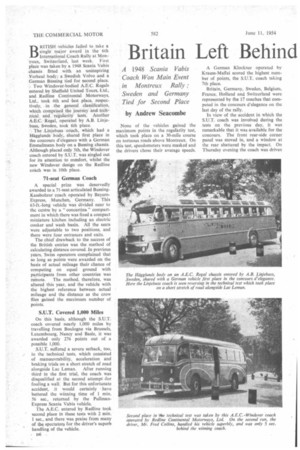Britain Left Behind Montreux
Page 68

Page 69

If you've noticed an error in this article please click here to report it so we can fix it.
A 1948 Scania Vabis Coach Won Main Event in Montreux Rally Sweden and Germany Tied for Second Place
by Andrew Seacombe
None of the vehicles gained the maximum points in the regularity test, which took place on a 30-mile course on tortuous roads above Montreux. On this test, speedometers were masked and the drivers chose their average Speeds. A German Klockner operated by Krauss-Maffei scored the highest number of points, the S.U.T. coach taking 7th place.
Britain, Germany, Sweden, Belgium, France, Holland and Switzerland were represented by the 17 coaches that competed in the concours d'elegance on the last day of the rally, In view of the accident in which the S.U.T. coach was involved during the tests on the previous day, it was remarkable that it was available for the concours. The front rear-side corner panel was stoved in, and a window at the rear shattered by the impact. On Thursday evening the coach was driven to a bodybuilding concern in Lausanne and was returned intact to Montreux at 11 o'clock the following morning!
The two coaches which were each awarded Grand ler Prix d'Honneurs were operated by Deutsche Touring Gesellshaft, Frankfurt, and A.B. Linjebuss, Stockholm. The German vehicle is employed on the Europabus service run jointly with the East Kent Road Car Co., Ltd.; and picks up passengers from Britain at Ostend.
A notable feature of the Emmelrnann bodywork was the beautifully finished toilet compartment at the rear. It was roomy, and its fittings included an electric razor. Two small hammers were clipped in holders on each side of the saloon with which passengers could break the glass in the event of emergency.
The entire saloon was given over to passenger comfort, all luggage being carried in a special trailer. Each of the 32 seats could be adjusted to three positions.
Tinted Plexi-glass—which was found 3n most of the Continental bodies'ormed the roof quarter panels of the I4-seat Hagglunds body entered by A.B. ...injebuss. Each seat had an individudly operated reading lamp, and a pushaitton lighted the appropriate seat lumber on an indicator board posiioned in front of the stewardess's desk. The driver's compartment, which also ad a seat for a spare driver, was rtally enclosed. Contact with the ewardess was maintained by telephone. Single seats were fitted along the near de of the coach which won the rally. perated by Pullman Express, its bodyork was utilitarian compared with the .her entries, the seats having come om an earlier body.
With the exception of a I-ft.-wide ,nel running the length of the, roof at the centre, the Gangloff bodywork above waist-level on a French-built Saurer operated by Cie Autobus-Messageries Cote d'Or, Dijon, consisted entirely of glass. Sliding panels, hand-operated from within the saloon, could convert the appearance to that of a conventional design, Normally a 45-seater, the seating capacity of this coach could be increased to 54 by bridging the gangway with folding slatted seats lined with Dunlopillo and covered with Rexine.
Another French competitor, Cia Exploit Automobile, Paris, featured a refrigerator and well-appointed toilet compartment in their underfloorengined Renault coach. Here, again, blue-tinted Plexi-glass was used for the roof quarter panels.
Krauss-Maffei, Munchen, built their own bodywork on the rear-engined Klockner they entered. All the gangway seats in this vehicle were designed to slide sideways, if required, a feature which I found in a number of other entries. Ventilation could be increased by lowering the top portions of each side window. By suspending the luggage racks from the roof in the rear-engined Sudwerke coach operated by W. Hartje, Hanover, the bodybuilder, Hubertia, has ensured maximum visibility through the tinted Sekurit safety-glass roof quarter panels. Each of the 46 individual seats was staggered and could be adjusted to three positions. There were 10 ventilators let into the roof.
Only in the S.U.T. Windover coach, in which I travelled the 800 miles from London to Montreux, did I find individual air-intakes similar to those used in aircraft. This vehicle, which had a full load of 30 passengers, had a toilet compartment, cocktail cabinet and a Calorgas water heater at the rear. A card table was fitted over the off-side rear wheel-arch.
In comparison, I considered the new Windover body on the Redline vehicle rather utilitarian. In this design they have reverted to the more conventional frontal treatment. One commendable feature I noted was the arrangement of the " Continental " step to the off-side entrance which is actuated by the movement of the door.




















































































































































